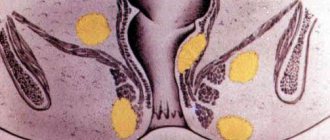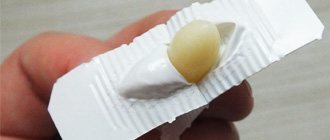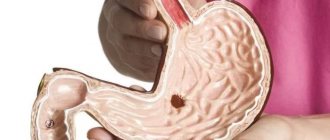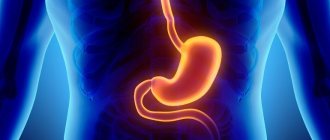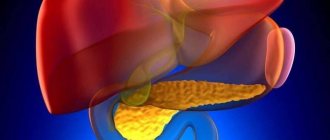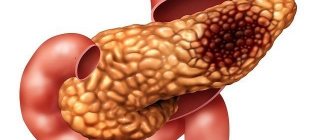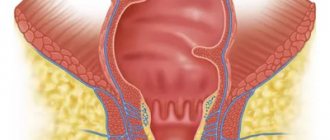Paraproctitis in children begins with inflammation of the anal glands or with acute bacterial infection in the tissues of the lower rectum. This happens because the body of newborn babies or very young children often cannot resist infections that cause various inflammatory diseases. Most often, children in the first year of life, mostly boys, suffer from paraproctitis, but the disease can also occur in older children. As in adults, paraproctitis in young children can occur in acute or chronic form.
Causes of paraproctitis
The main causes of paraproctitis in infants may be:
- Violation of the formation of microflora of the gastrointestinal tract.
- Pathologies of the rectal mucosa.
- Microtraumas of the perianal area and intestines.
- Frequent stools.
- Constipation, causing stagnation of feces.
- Underdeveloped immune system.
- Violation of sanitation and hygiene rules.
The onset of paraproctitis in infants is caused by infection in the area of the anal glands and/or anal sinus. The mixed microflora contains various bacteria, mainly Escherichia coli or staphylococcus. Then the infection begins to affect the fiber (adipose tissue) of the peri-rectal area. The resulting abscess can spontaneously open in the absence of the necessary treatment.
The rapid spread of the inflammatory process during paraproctitis occurs through the abnormal ducts of the anal glands, which have numerous channels and branches, creating favorable conditions for the spread of infection. In this case, pus affects various internal organs of the child. This can lead to serious consequences and cause various additional general diseases.
Etiology and mechanisms of development
In childhood, paraproctitis has some features that distinguish the disease from the pathological process occurring in the adult body.
In the first case , monomicrobial flora is sown, in the second - mixed microbial flora .
The inflammatory process develops gradually.
To begin its formation, there must be trauma to the mucous membranes or stagnation of feces. The formation of obstruction of the duct becomes the cause of a retention growth, after opening of which the infection enters the perianal region.
The mechanism of development of the disease occurs in the following stages:
- Opening the retention growth.
- Spread of purulent masses throughout neighboring organs and systems.
- Formation of acute paraproctitis.
Diagnosis of paraproctitis
A proctologist diagnoses paraproctitis based on the results of an examination using palpation.
This will allow you to determine the location of the abscess and its size. The baby is given a blood test to determine the white blood cell count and erythrocyte sedimentation rate (ESR), which are the main signs of a bacterial infection.
If necessary, ultrasound examination (ultrasound) is prescribed. The presence of purulent discharge from fistulous canals in the anus or rectum is also a typical symptom of the disease.
Clinical picture
In acute paraproctitis in children under one year of age, general signs of intoxication of the body are observed. Inflammation is accompanied by an increase in body temperature above 380C. The baby becomes capricious and difficult to calm. Even after a long time, the child refuses to eat.
The symptoms of manifestations in the acute form of the disease are characterized by a decrease in general reactions, and the urge to defecate is accompanied by crying. The same thing happens if a child passes gas. In a sitting position, severe pain appears, this is indicated by crying. This causes constipation in the child.
When a diagnosis is carried out by examining the sphincter area, the doctor notes redness and thickening. The child reacts by crying to attempts to touch the nodules.
Signs that require medical attention
Children's paraproctitis begins to show the first signs after 24 hours. Only by the 2nd or 3rd day does pus appear and is discovered after defecation. Mucus begins to come out of the rectum along with feces. Many manifestations of acute paraproctitis in infants are confused with teething. Therefore, it is worth examining the anus if pus is detected.
Each type of paraproctitis has features of manifestation:
- the subcutaneous appearance is diagnosed by external signs of redness and abscess formation;
- the submucosal appearance is characterized by elevated temperature, but the abscess is not detected.
When it is difficult to determine inflammation in the rectum, the condition is complicated by a breakthrough of the abscess. This leads to sepsis, which is accompanied by fever and sometimes vomiting. In this case, the child needs the help of a proctologist and an ambulance is immediately called.
How not to confuse it with inflammation of hemorrhoids?
Paraproctitis in children manifests itself with similar symptoms as hemorrhoids. A distinctive feature is the absence of fever. The baby remains as active as before, weakness does not appear and general malaise does not bother him.
The appearance of an inflammatory process on hemorrhoids occurs due to physical activity. The disease develops slowly, and symptoms appear after 2-3 months. Unlike hemorrhoids, paraproctitis can manifest itself in the form of an abscess within 1 week. The timing of the onset of this symptom varies from person to person. However, paraproctitis in newborns can be a complication of hemorrhoids.
Manifestation of the chronic form
The difference from the acute form is the presence of a fistula canal. It has 2 holes going into the inner and outer sides.
Sometimes the appearance of fistulas is associated with a congenital anomaly. Incomplete fistulas after infection are transformed into a complete type of fistula.
When an exacerbation of the disease occurs, the symptoms are similar to the acute form. However, the symptoms are mild. Chronic paraproctitis is characterized by frequent relapses. Sometimes a fistula can go away on its own and not appear for a long period.
Paraproctitis acute and chronic
Based on the area where the abscess is located, the disease is classified into the following types:
- submucosal paraproctitis;
- subcutaneous paraproctitis;
- ischiorectal paraproctitis (ischiorectal);
- pelviorectal paraproctitis (pelvic-rectal);
- retrorectal paraproctitis.
Young children most often suffer from acute subcutaneous paraproctitis. Less commonly, they have pelviorectal, ischiorectal, submucosal and subcutaneous mucosal paraproctitis.
During acute childhood paraproctitis, in addition to the above symptoms, severe crying during defecation and pain in the anus are observed. Intense redness (bumps) form on the skin around the anus, painful and hot to the touch. The buttocks turn red and become swollen, hard and painful. The folds of the anal mucosa are smoothed out.
Children's paraproctitis acquires a chronic form after the formation of a fistulous tract with an internal or external opening. A complete fistula has access to the skin and rectum. An incomplete open fistula is not connected to the rectum, but goes directly to the skin. An incomplete closed fistula extends into the rectum and ends in the peri-rectal tissue, without having an external outlet to the skin.
A fistula tract in an infant may appear as a result of congenital pathology. When an infection gets into it, the incomplete fistula tract becomes complete. Fistulas in children form inside the sphincter, i.e., the anal muscles that close the entrance to the rectum. Chronic paraproctitis can periodically worsen. The symptoms are similar to those of acute paraproctitis.
Complications of the disease
Serious consequences can be caused by both acute and chronic paraproctitis.
The acute form most often provokes the following complications:
- Opening an abscess on the surface of the skin;
- Melting with pus of the rectum, vagina in females;
- Damage to the pelvic tissue;
- Melting of the intestinal wall above the anorectal region, release of pus into the perirectal tissue, spread of inflammation;
- Breakthrough of the abscess into the abdominal cavity or beyond it, development of peritonitis;
- Melting of the walls of the urethra;
- Spread of infection from one cell to another.
The chronic form is accompanied by repeated inflammation and the appearance of scar tissue. As a result, the anal canal narrows and becomes deformed. This also applies to the rectal sphincter.
Treatment of paraproctitis
In the initial stages of paraproctitis, antibiotics, anti-inflammatory and local antiseptics are used. In particular, in order to prevent the development of suppuration and the transition of the disease to a chronic form, ichthyol ointment, Vishnevsky ointment, disinfecting and anti-inflammatory suppositories, and mild antibiotics are used as prescribed by a doctor.
In addition, warm sitz baths with a solution of potassium permanganate or other disinfectant are used for newborns. The temperature of the solution in the bath should be about 39-40°C.
If a small child cannot sit yet, then sitz baths are replaced by bathing in weak disinfectant solutions 2-3 times during the day and in the evening before bed.
Preventive measures play a very important role in reducing the likelihood of infection in the fistulous tract during paraproctitis. They include timely removal of feces from the anal area, careful care of the skin in the anus. In addition, gentle massage of the peritoneum to prevent constipation or the use of mild laxatives to prevent stagnation of feces in the child’s intestines can help.
If acute paraproctitis develops in a child, mandatory surgical intervention is required. Usually, an operation to excise the affected tissue and drainage of the pus accumulated at the site of infection is performed only after the fistulous tract is fully formed, that is, as a rule, not earlier than the child reaches two years of age. During the surgical intervention, pus and scarred tissue are removed from the affected area, and the fistula tract connecting the rectum with the pustular cavity is closed by excision or ligation.
After a surgical operation to remove pus and eliminate a fistula due to paraproctitis in a child, a drainage tampon with Vishnevsky ointment is installed into the surgical incision, preventing premature closure of the wound cavity. The tampon is finally removed, usually two to three days after surgery. At this time, a special diet is prescribed. For stool retention, cleansing enemas are used. In some cases, additional drug treatment with restoratives and antibiotics is required.
In the absence of complications and inflammatory processes in the area of excision of the affected tissue in a sick child, a complex of restorative postoperative procedures can be performed on an outpatient basis. Most often, if the doctor’s recommendations are followed, surgical treatment of paraproctitis is successful and leads to a complete recovery of the little patient. In very rare cases, complications, relapses or the development of a chronic form of the disease are possible.
Prognosis and prevention
Most young patients recover completely after proper treatment. The prognosis of the disease is favorable, the statistical probability of mortality is close to zero. In order to prevent complications, parents should be attentive to changes in the child’s condition and consult a doctor at the first suspicious symptoms. You cannot self-medicate with folk remedies - this method will lead to the fact that the clinical picture will be erased, and the acute inflammatory process will become chronic.
It is necessary to take preventive measures to avoid the disease:
- regular thorough hygiene of the perineum and anal area;
- combating constipation and diarrhea;
- preventing injuries in the anal area;
- timely treatment of infections;
- balanced diet appropriate for age;
- clearly established sleep and wakefulness patterns.
General health procedures that strengthen the immune system are of great importance - hardening, physical activity, walks in the fresh air.
Following simple rules of prevention will reduce the risk of paraproctitis and relieve the child from stress associated with medical procedures.
Paraproctitis in children: prevention
Measures to prevent the occurrence of paraproctitis include:
- Prevention of constipation in children.
- Elimination of microtraumas of the anal area.
- Preventing damage to the mucous membranes of the rectum by foreign objects.
- Compliance with sanitation and hygiene rules.
- Regular medical examination of the child.
- Treatment of provoking intestinal infections.
- General strengthening procedures.
- Organizing a proper diet.
As already indicated, the causes of paraproctitis in a child include staphylococcal or intestinal infection, frequent bowel movements in the presence of anomalies of the anal gland ducts. Paraproctitis can also be caused by constipation or congestion in the rectum, general weakness of the body and disorders of the child’s immune system.
Prevention of paraproctitis in children is thus aimed at eliminating causes that can cause inflammation and suppuration of the tissues of the lower rectum. Preventive measures can prevent or significantly alleviate the course of the disease. It should be noted that treatment of paraproctitis will be most effective in the earliest stages of the disease.
